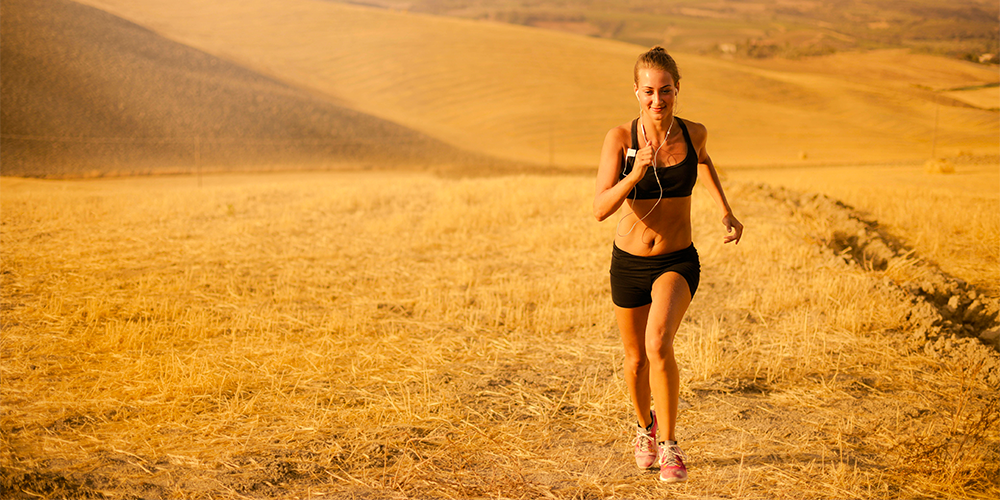Have you ever thought about running in the morning on an empty stomach? Running on an empty stomach can boost your fat metabolism and give you a refreshed feeling for the day. But how exactly should you go about it?
First things first: once you’ve discovered how liberating and refreshing it can be to run leisurely step by step into the day as your first activity, you’ll love the feeling, regardless of whether it’s the non plus ultra in terms of training or just an ordinary long run.
But why is a fasted run interesting? In the morning after getting up, glycogen stores are not quite full and insulin levels are low. If you train in this state, so the theory goes, your metabolism doesn’t run in “carbohydrate mode,” but instead the body makes increased use of fat as fuel, thus training its fat metabolism. In endurance sports, the more economically the fat metabolism functions, the more carefully the carbohydrate reserves can be used. In order to be able to perform for as long as possible during long sessions and/or competitions, it makes sense to train your fat metabolism. Top Kenyan runners, for example, always complete their first endurance run of the day on an empty stomach before their morning meal.
What needs to be considered in the fat burning theory
The body can only gain energy mainly from fat reserves if enough oxygen is available. In other words: Fasting runs should be done at a relaxed pace so that you can easily talk while doing them. If you run too fast, you will draw more on your carbohydrate reserves. Another point: fat metabolism training has basically nothing to do with losing weight. Although you burn more fat in percentage terms at a moderate pace than during intense workouts, you still burn less in absolute terms because intense workouts also require far more energy than slow ones.

The most important points about fasting running:
Pace
- Talking pace, ±120 heart rate is enough, so the oxygen shower refreshes not only the body but also the mind.
- No interval training or tempo runs. After getting up, many still feel stiff and immobile, so approach the fasting run very loosely is mandatory. A too intense cold start of the muscles can lead to injuries. And tendons, ligaments and joints should also be prepared for the day at a more leisurely pace.
When
- In the morning Fasting, without breakfast, directly after getting up. Drink a sip of water or tea, but then get into your running shoes and off you go! If you need to get your circulation going with a coffee first – go ahead!
- The last meal should have been consumed at least 6-8 hours before.
- If it is still dark – don’t forget your headlamp!
Duration
- If you are not (yet) familiar with the fasting run, you should start in small doses and perhaps start with 20 minutes at first. Feel your way slowly and observe whether it works with your cycle.
- Depending on your condition and health, you can increase to 40-60 minutes. And if you have enough time and are used to fasting runs, you can also complete your LSD run (Long Slow Distance) for up to two hours. But at best with an emergency carbohydrate ration in your pocket, just in case you get hungry.
Where
- If possible, directly from the front door. Don’t get into the car first, that only complicates the start unnecessarily and eats up time.
- Fasting runs are suitable anywhere, even on vacation. Nothing is needed except clothes and shoes. Do you know the Eiffel Tower, Broadway or the Copacabana at 5:30 in the morning? With fasting runs, you’ll get to know a neighborhood completely new, especially at dawn.
- Pick a route that suits your time frame.
Weather
- Yes, of course, always, even in bad weather. Or even more so, because then really only the hardy are outside. And breakfast tastes just that much better after a bad weather run!
Time
- Everybody has 24 hours every morning until the next morning – including you! There is no such thing as no time!
Frequency
- The fasting run is great for body and soul, but as running content it is one training tool of several. It should therefore not be practiced exclusively. The run with an empty stomach serves to relax and to set a new training stimulus and to bring variety into the daily training routine. It is best combined with other running workouts at other times of the day.
Conclusion
Fasting runs not only set new physical adaptation processes in motion in the body, but also exert a special fascination in terms of experience. The air in the early morning is measurably better than in the evening, the agenda is still sparkling clean, the zest for action is still there, the batteries are full, the creativity is great. You will see: The best ideas will come to you early in the morning, you will be able to structure the day ahead and you will be one – not only sportive – step ahead of everyone.
Once you’ve had a taste of sober running, you won’t want to miss it. And the best thing about it: After a fasting run, the recommended health motto “eat breakfast like an emperor” applies doubly!
Fasting Training – from Pyjamas Straight to Running Shoes
This blog post by Andreas Gonseth was provided by Fit for Life . Fit for Life is the Swiss magazine for fitness, running and endurance sports. Would you like to read articles like this regularly? Then Click here.


